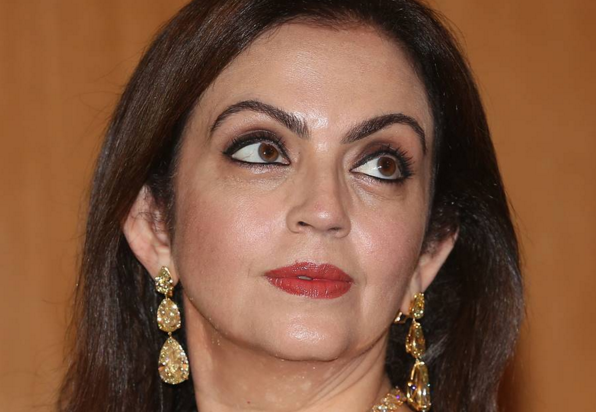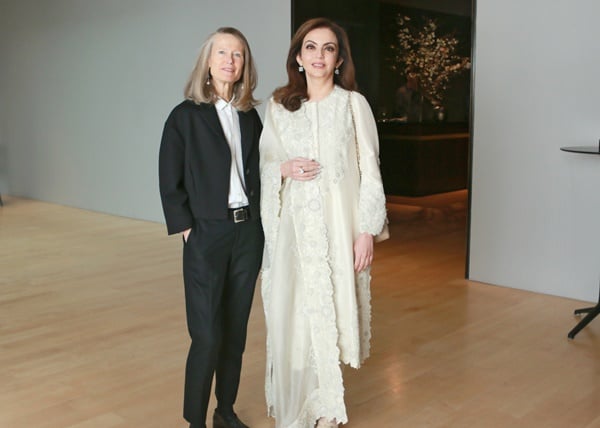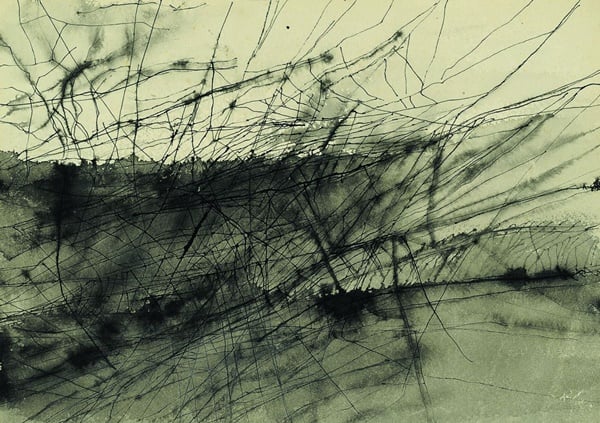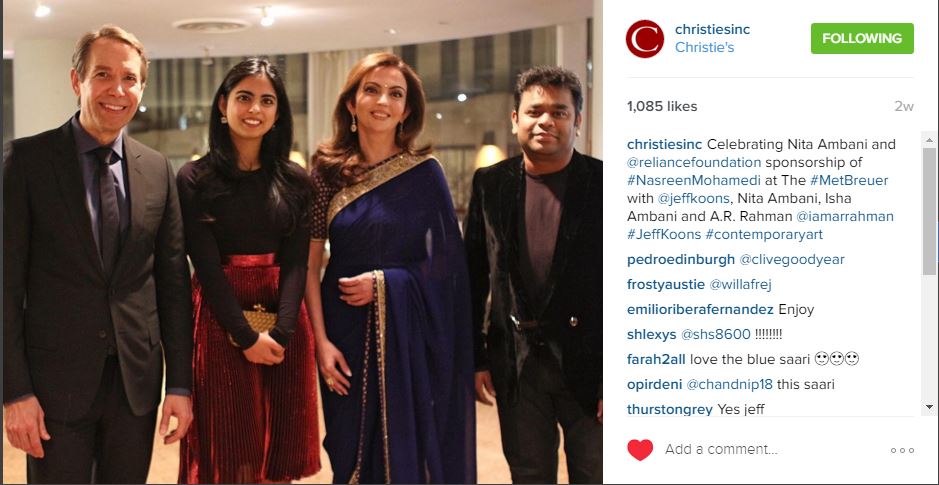Art Guides
Collector Nita Ambani Is Expanding Her Empire Through an Ambitious New Show at Met Breuer
Fine art is the next frontier.

Fine art is the next frontier.

Eileen Kinsella

On Nita Ambani’s most recent visit to New York earlier this month, a staffer at the Met Breuer, the Metropolitan Museum’s new modern and contemporary outpost on Madison Avenue, asked her what she did there.
Ambani, a collector, philanthropist, and founder and chairperson of the Reliance Foundation, had been spending so much time at the museum, the employees assumed she worked there.
She recounted the story with a laugh, while seated in the private collector lounge of the Met’s main Fifth Avenue building, an elegantly appointed, sprawling room that overlooks Central Park.
Ambani, who is perhaps best known through her marriage to Reliance Industries chairman and managing director Mukesh Ambani, aka India’s richest man, does not work for the Met, of course. But she is used to drawing attention. Through her extensive wealth and philanthropic efforts, she has been the subject of much discussion in Mumbai, as well as for her 400,000-square-foot residence on Altamount Road, which a 2012 Vanity Fair profile refers to as “a 27-story…Xanadu that few have entered but that has all Mumbai buzzing.”

(L to R) Metropolitan Museum of Art modern and contemporary art director Sheena Wagstaff with Reliance Foundation chairperson Nita Ambani.
Image: Courtesy of the Metropolitan Museum of Art.
She and Mukesh are the main sponsors of the recently-opened solo show of Indian abstract painter Nasreen Mohamedi (1937–1990),”Waiting Is a Part of Intense Living.” The exhibition made its debut at the Reina Sofia Museum in Spain this past September, and is now building up an audience at the Met’s new building.
The roots of the Mohamedi show date back several years, but the Ambanis jumped in just this past December and embraced the opportunity to sponsor it, as part of their efforts to become more involved in the art world. Until recently, Ambani, who is trained in classical Indian dance, had been mostly focused on performing arts.

Nasreen Mohamedi Untitled, (circa 1960s).
Ink on paper. Private Collection.
©Estate of Nasreen Mohamedi / Courtesy Talwar Gallery, New York / New Delhi.
Sheena Wagstaff, chairman of modern and contemporary art at the Met, first saw Mohamedi’s work at Documenta 12 in 2007. “I was very moved and intrigued by her practice, because it was so powerful and unlike any other work I’d seen, particularly from South Asia,” she said in an email to artnet News.
A few years later, when considering the programming for the Met Breuer, she learned of the Reina Sofia show, which had the collaboration of the Kiran Nadar Museum of Art in New Delhi. It is “promising and signally important that the work of a South Asian artist is being supported by equally significant Indian philanthropic endeavors,” says Wagstaff.

For her part, Ambani calls the Met Breuer’s decision to open with a show by an Indian artist “historic and momentous.” It certainly fits with her own interest in giving a broader platform to showing the work of India’s modern masters, and with her emphasis on gender equality in art and in life.
The Mohamedi show is a source of pride “for all Indians, but especially Indian women.” Ambani says. She continues, “In a very patriarchal society, here is a woman who was creating such strong, important, and assertive works.”
Gender equality is also a priority in the foundation’s initiatives, she explains. In an effort to help alleviate treatable issues relating to blindness, the Reliance Foundation funds a wide-ranging corneal transplant program in India. At the time, she was dismayed to find that 90 percent of recipients were men, an aspect which she immediately addressed. “The sense is that men must have the priority in a family, but it has to be 50-50 male and female,” she says.
Ambani concedes that visual fine arts has been a more recent focus, noting: “I’m just starting the journey.” But she has been moving fast. Just this past fall, the collecting couple were the lead sponsors for the Art Institute of Chicago’s much-lauded landmark show, “Gates of the Lord: The Tradition of Krishna Paintings.”
That show, which ran from September 2015 to January 2016, marked the first large-scale exploration at a US museum of the aesthetics of the Pushtimarg sect of Hinduism.
In addition to promoting “firsts” for Indian art in the West, she wants to also show Western art in her home country. She is planning to build a convention center in Mumbai, slated for 2018, with an ambitious space that could potentially host top museum exhibitions from around the world. “Art brings people together in so many ways,” she says.
Her sense of being in the early stage of the journey also extends to her own collecting. She owns Indian miniature paintings as well as some “pichvais” that she loaned to the Art Institute of Chicago. So far, she says she has bought “What I like to look at.”
But she definitely has her finger on the pulse of collectible contemporary names. She recently gifted a Tracey Emin neon sculpture, When I Hold You, I Hold Your Heart to her daughter Isha. Ambani says of the Emin piece: “It’s neon, its bright, fun, happy, lovely.”
And not surprisingly, some blue-chip Indian artists are part of the collection as well, including Anish Kapoor, whose practice she describes as “almost a form of physics, the way he creates illusions with light.”
Ambani further commissioned a work by Subodh Gupta, a nine-foot installation made with his signature brass and steel pots. “The brass portion forms the map of Mumbai,” says Ambani. This is especially evocative of “childhood vacations in Gujarat, where all the vessels were made of brass.”
The works are currently only on view in her massive Mumbai home, and an invitation is certainly required.